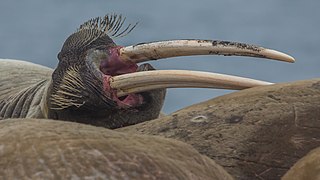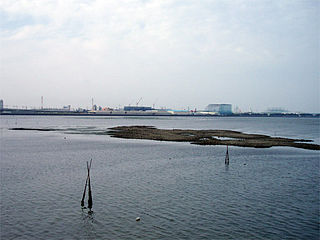Related Research Articles

A salt marsh, saltmarsh or salting, also known as a coastal salt marsh or a tidal marsh, is a coastal ecosystem in the upper coastal intertidal zone between land and open saltwater or brackish water that is regularly flooded by the tides. It is dominated by dense stands of salt-tolerant plants such as herbs, grasses, or low shrubs. These plants are terrestrial in origin and are essential to the stability of the salt marsh in trapping and binding sediments. Salt marshes play a large role in the aquatic food web and the delivery of nutrients to coastal waters. They also support terrestrial animals and provide coastal protection.
The National Ocean Service (NOS) is an office within the U.S. Department of Commerce, National Oceanic and Atmospheric Administration (NOAA). It is the responsible for preserving and enhancing the nation's coastal resources and ecosystems along approximately 95,000 miles (153,000 km) of shoreline, that is bordering 3,500,000 square miles (9,100,000 km2) of coastal, Great Lakes and ocean waters. Its mission is to "provide science-based solutions through collaborative partnerships to address the evolving economic, environmental, and social pressures on our oceans and coasts." The offices works with partnered agencies to ensure that the ocean and coastal areas are safe, healthy, and productive. It`s projects focus on working to ensure the safe and efficient marine transportation, promoting the protection of coastal communities, conserving marine and coastal places. It employs 1,700 scientists, natural resource managers, and specialists in many different fields. The National Ocean Service was previously also known as the National Ocean Survey until it was renamed in 1983.

Geobacter is a genus of bacteria. Geobacter species are anaerobic respiration bacterial species which have capabilities that make them useful in bioremediation. Geobacter was found to be the first organism with the ability to oxidize organic compounds and metals, including iron, radioactive metals, and petroleum compounds into environmentally benign carbon dioxide while using iron oxide or other available metals as electron acceptors. Geobacter species are also found to be able to respire upon a graphite electrode. They have been found in anaerobic conditions in soils and aquatic sediment.

Bioturbation is defined as the reworking of soils and sediments by animals or plants. It includes burrowing, ingestion, and defecation of sediment grains. Bioturbating activities have a profound effect on the environment and are thought to be a primary driver of biodiversity. The formal study of bioturbation began in the 1800s by Charles Darwin experimenting in his garden. The disruption of aquatic sediments and terrestrial soils through bioturbating activities provides significant ecosystem services. These include the alteration of nutrients in aquatic sediment and overlying water, shelter to other species in the form of burrows in terrestrial and water ecosystems, and soil production on land.
The Office of Response and Restoration (OR&R) is a program office of the National Ocean Service and a natural resource trustee that protects the coastal environment from oil and hazardous material releases and restores damage caused by such releases.

The Cochato River is a stream rising from Avon, Massachusetts and running several miles north to its confluence with the Monatiquot River in Braintree. It is part of the Weymouth Fore River watershed and empties into Boston Harbor. The river serves as the boundary between Braintree and Randolph.

California's coastal salt marsh is a wetland plant community that occurs sporadically along the Pacific Coast from Humboldt Bay to San Diego. This salt marsh type is found in bays, harbors, inlets, and other protected areas subject to tidal flooding.

Judith Shulman Weis is an American marine biologist. Her research and writing focuses on estuarine ecology and ecotoxicology, including the responses of salt marsh and brackish marsh organisms, populations and communities to stresses, particularly heavy metal contaminants, invasive species and parasites. She is also working to reduce the spread of microplastics in the environment and find solutions to protecting coastal marshes from sea level rise.
Microbial inoculants, also known as soil inoculants or bioinoculants, are agricultural amendments that use beneficial rhizosphericic or endophytic microbes to promote plant health. Many of the microbes involved form symbiotic relationships with the target crops where both parties benefit (mutualism). While microbial inoculants are applied to improve plant nutrition, they can also be used to promote plant growth by stimulating plant hormone production. Although bacterial and fungal inoculants are common, inoculation with archaea to promote plant growth is being increasingly studied.
The Montrose Chemical Corporation of California was a chemical corporation that was the largest producer of the insecticide DDT in the United States from 1947 until it stopped production in 1982. Its improper disposal of chemical waste from DDT production resulted in serious environmental damage to the Pacific Ocean near Los Angeles, and its former main plant in Harbor Gateway South area of Los Angeles near Torrance, California has been designated as a Superfund site by the United States Environmental Protection Agency.
The Water Resources Development Act of 1992, Pub. L.Tooltip Public Law 102–580, was enacted by Congress of the United States on October 31, 1992. Most of the provisions of WRDA 1992 are administered by the United States Army Corps of Engineers.

Oyster reef restoration refers to the reparation and reconstruction of degraded oyster reefs. Environmental changes, modern fishing practices, over harvesting, water pollution, and other factors, have resulted in damage, disease, and ultimately, a large decline in global population and prevalence of oyster habitats. Aside from ecological importance, oyster farming is an important industry in many regions around the world. Both natural and artificial materials have been used in efforts to increase population and regenerate reefs.
Cycloclasticus pugetii is a species of bacterium found in marine sediments. It is notable for being able to break down aromatic hydrocarbon, including naphthalene, phenanthrene, anthracene and toluene. It is an aerobic, gram-negative, rod-shaped bacterium from the family Piscirickettsiaceae, and it is motile by means of single polar flagellum. Strain PS-1 is its type strain. It was named in honor of Peter Puget.

The Great Chelsea fire of 1908, also known as the first Great Chelsea fire, was a conflagration that occurred on April 12, 1908, in Chelsea, Massachusetts, a city directly across the Chelsea River from East Boston. Nineteen people were killed, 15,000 were left homeless, and 350 acres (140 ha) were burned in the fire. The fire started 200 yards (180 m) away from the Great Chelsea fire of 1973.
Microbiomes of the built environment is a field of inquiry into the communities of microorganisms that live in human constructed environments like houses, cars and water pipes. It is also sometimes referred to as microbiology of the built environment.
Stilbonematinae is a subfamily of the nematode worm family Desmodoridae that is notable for its symbiosis with sulfur-oxidizing bacteria.
Geobacter uraniireducens is a gram-negative, rod-shaped, anaerobic, chemolithotrophic, mesophilic, and motile bacterium from the genus of Geobacter. G. uraniireducens has been found to reduce iron and uranium in sediment and soil. It is being studied for use in bioremediation projects due to its ability to reduce uranium and arsenic.
Nancy Tuchman is an American environmental scientist, educator, and activist. She specializes on human impacts on aquatic ecosystem function, with a focus on coastal Great Lake ecosystems. Tuchman is dedicated to raising public awareness about issues of global climate change and education. Her dedication is shown through her thirty years of educating students in environmental sciences at Loyola University Chicago. In 2013 she founded the Institute of Environmental Sustainability on Loyola University's campus - which later became the School of Environmental Sustainability in late 2020 - and is a driver of environmental change and progress in the Chicago area.
Jonathan Richard Lloyd is a professor of geomicrobiology and director of the Williamson Research Centre for Molecular Environmental Science, and is based in the Department of Earth and Environmental Sciences at the University of Manchester. His research is based at the interface between microbiology, geology and chemistry. His research focuses on the mechanisms of microbial metal-reduction, with emphasis on the environmental impact and biotechnological applications of metal-reducing bacteria. Some of the contaminants he studies include As, Tc, Sr, U, Np and Pu. Current activities are supported by funds from NERC, BBSRC, EPSRC, the EU and industry. Lloyd is also a senior visiting fellow at the National Nuclear Laboratory, which helps support the development of a nuclear geomicrobiology programme.
Hydrocarbonoclastic bacteria are a heterogeneous group of prokaryotes which can degrade and utilize hydrocarbon compounds as source of carbon and energy. Despite being present in most of environments around the world, several of these specialized bacteria live in the sea and have been isolated from polluted seawater.
References
- ↑ "Island End River". Geographic Names Information System . United States Geological Survey, United States Department of the Interior . Retrieved June 28, 2023.
- 1 2 "Island End River | Hazardous Waste | Damage Assessment, Remediation, and Restoration Program". darrp.noaa.gov. NOAA Restoration Center. Retrieved 3 June 2023.
- ↑ Daniel, Seth (August 20, 2020). "Island End River Work by Everett, Chelsea Gets Glowing Reviews – Chelsea Record". Chelsea Record.
- ↑ Daniel, Seth (March 21, 2021). "Island End River Unearthed in a Parking Lot – Everett Independent". Everett Independent.
- ↑ Hayes, L. A.; Lovley, D. R. (2002). "Specific 16S rDNA Sequences Associated with Naphthalene Degradation under Sulfate-Reducing Conditions in Harbor Sediments". Microbial Ecology. 43 (1): 134–145. ISSN 0095-3628.
- ↑ Chin, Kuk-Jeong; Sharma, Manju L.; Russell, Lyndsey A.; O'Neill, Kathleen R.; Lovley, Derek R. (2008). "Quantifying Expression of a Dissimilatory (bi)Sulfite Reductase Gene in Petroleum-Contaminated Marine Harbor Sediments". Microbial Ecology. 55 (3): 489–499. ISSN 0095-3628.